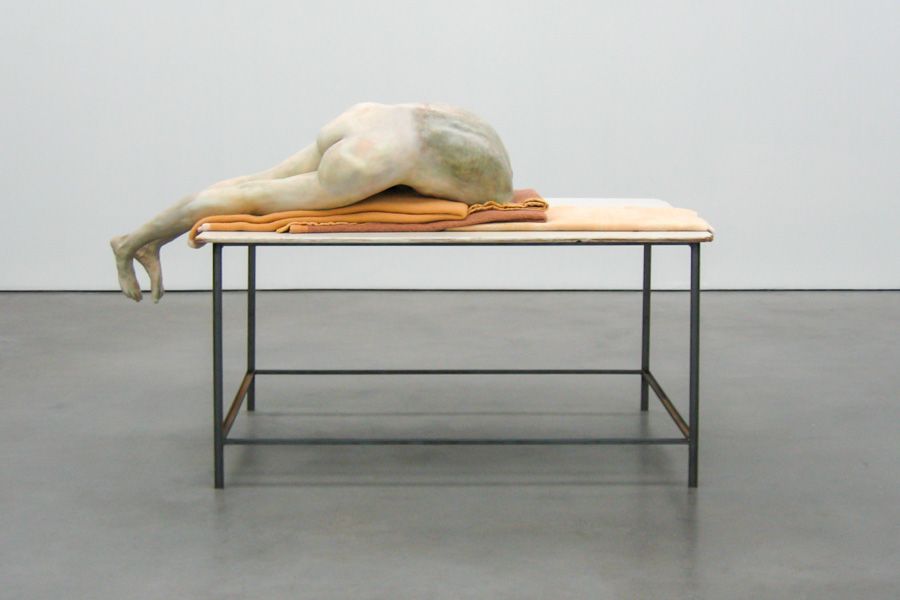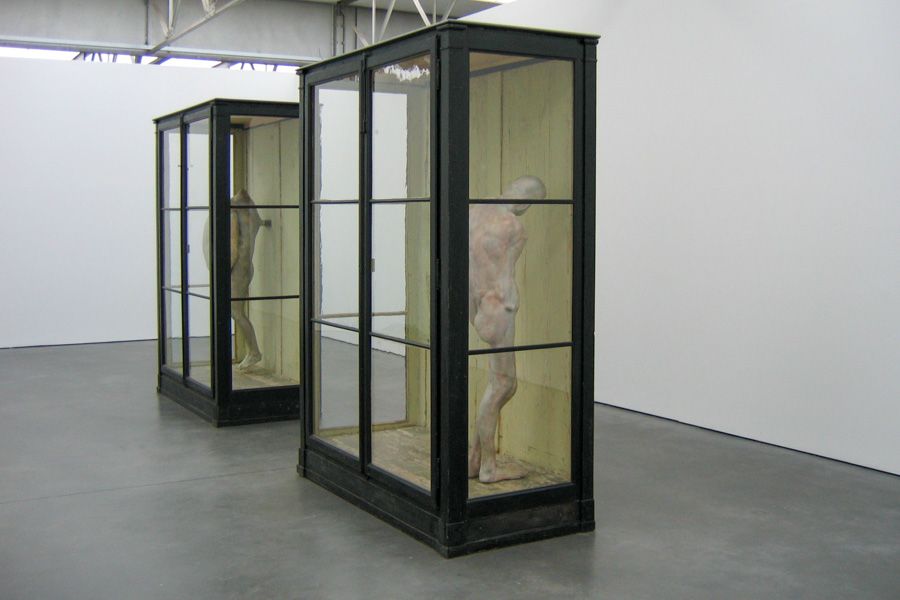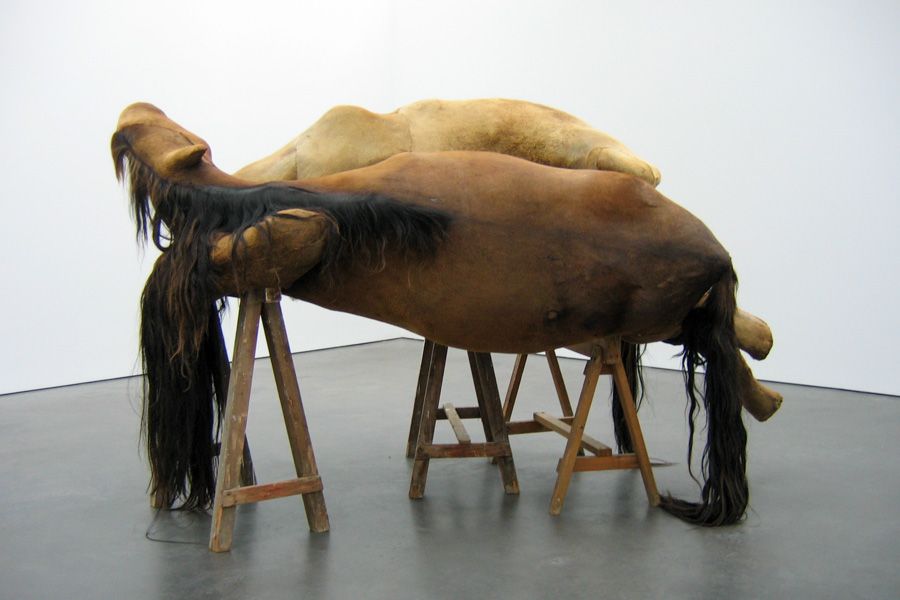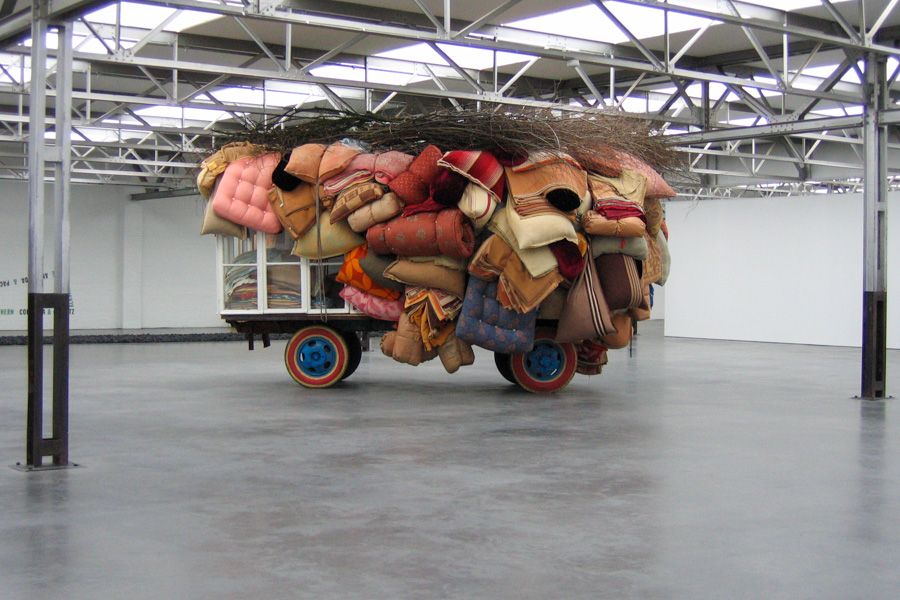Upon entering the main hall of the De Pont Museum of Contemporary Art my attention is instantly drawn towards a large trailer loaded with blankets, pillows, mattresses and branches. I cannot help noticing that it stands where, until a few weeks ago, there used to be a circle of white stones by Richard Long. I wonder how long it took to remove them all and whether each stone was numbered. You can still make out the work's contours from the slight discolourization of the floor. It makes me think of some other works by Richard Long, which he created by walking a circle or a line in a landscape. They could have made a new sign, Richard Long, "Untitled" (2005).
Like the piece by Richard Long, the trailer, a work by the Belgian artist Berlinde de Bruyckere ("The Zone", 1996), fits perfectly into the space. If you didn’t know better or notice the traces on the floor, you would think it has always been there. I wouldn’t be surprised if the museum were to decide to acquire it, as it frequently does following a temporary exhibition. It has a very commanding presence. Images of refugees cross my mind as I look at it. Berlinde de Bruyckere created the work at a time when the wars in former Yugoslavia and Rwanda made news headlines. The times have changed, but the images haven’t, only the location has.
Until some years ago Berlinde de Bruyckere was known in the arts world for her frequent use of blankets in her installations and sculptures. In 1999 she created an installation consisting of several beds with piles of blankets laid on top in which some holes had been cut out. Her sculptures too were frequently wrapped in blankets, leaving only the legs visible. It has been pointed out, perhaps too often, in relation to her work, that a blanket offers shelter, but that it can also suffocate. To me the blankets not only serve as a metaphor for the vulnerability of the body, they also offer a place to hide from the voyeuristic gaze of the world outside.




Berlinde de Bruyckere at De Pont, Tilburg, The Netherlands (2005)
In 2000, when she was artist-in-residence at the In Flanders Fields Museum in Ieper, Belgium, a museum dedicated to the First World War, Berlinde de Bruyckere created an installation consisting of five horse bodies. While browsing through the museum’s photo archives she had been struck by the images of corpses of horses lying in the streets. One reason these images are so tragic is that animals have no part in the conflicts between men. During Sonsbeek 9, an open air sculpture exhibition in and around Arnhem, The Netherlands, she hung a couple of horses from a tree, as if they had been blown away by a blast, although according to Berlinde de Bruyckere they could also stand for Pegasus, the mythical flying horse. Having fallen from the sky, his fall might have been broken by the tree.
For her horse sculptures De Bruyckere used to make models of actual horse bodies in a horse-slaughterer’s yard, which she then covered with real hides. Today she sculpts the bodies herself, but she still uses real hides. Abstraction has made them even more powerful.
In the exhibition at De Pont a recent work ("Joined", 2003-2004) shows two horses, their bodies stitched together, resting on three wooden trestles, the hair of the tails touching the ground. It is a poignant image. Horses don’t usually lie down, they just stand there, and when they do, they instantly get up. I had to fight the urge to caress them, - this is a museum -, to let my fingers run through the hair and to tell them that it’s OK, that they’ve been loved and will be remembered.
It is one of several pieces in the exhibition in which bodies have been stitched together or, as in the case of the wax sculptures, merged. Some share the same title "Eén" (One), which is also the title of the exhibition, or "Aanéén", which means so much as joined or together. Stitching is what you do when you sew up a wound. In the work of De Bruyckere two or more bodies are stitched together, emphasizing their belonging together, their closeness and their unity. It also means that they can only be separated by an act of force that will rip both bodies apart.
In one room two headless figures lie on some old brown blankets that have been carefully laid on a table. Their bodies appear to have melted together. It has an obvious erotic dimension, but when I noticed the bluish skin tones and the shrivelled feet of one of the figures, images of refugees and death camps again crossed my mind. Maybe this is all these figures have, a blanket and each other.
The show at De Pont consists primarily of work from the last few years, both sculptures and drawings. One of the most recent works is dated 2004-2005. It must have been finished days before the opening. It shows two legs hanging like wet laundry from a wooden post. There are unmistakable religious connotations here.
The figures in De Bruyckere’s drawings and watercolours are every bit as frail as her sculptures. They show people squatting and making themselves small. One series of drawings shows a head, the hair combed across the face, the eyes as penetrating greyish white holes. What are these figures ashamed of? Perhaps of being human. “Innocence can be hell”, as the title of an earlier work by De Bruyckere says.
With her choice of material and subject matter one can see in De Bruyckere’s work references to other artists, Joseph Beuys, Pavel Althamer, Mike Kelley and Louise Bourgeois come to mind. As always such comparisons only serve to show what is unique about each individual artist.
Centrepiece of the exhibition is "One" (2003-2004). It consists of two man-size cupboards with a glass front. Like most of the supporting materials in De Bruyckere’s work, tables, shelves, cupboards, the paper she draws on, it looks worn-out, which is another way of saying that it has a history. Inside there are nude figures, their heads deformed as in a Francis Bacon painting.
The figure in the right display reminds me of how, at my primary school, teachers used to punish children by sending them off to stand in the corner of the classroom for 10 or 15 minutes, their heads facing the wall. It is only now that I realize what a weird penalty this actually was. On the rare occasion that I myself was sent off to stand in the corner I remember being terribly ashamed as I felt the eyes of the entire classroom piercing my back.
The two figures in the left display could be frozen in the act of having sex, but they may also be holding on to each other, their faces buried inside each other so as not to see whatever is happening behind their back. When you take a closer look you notice that the feet of the stretched figure don’t touch the ground. They remind me of the bodies recovered in Pompei and of Michel Houèllebecq’s novel The Elementary Particles. Maybe this is how years from now, mankind will be displayed and looked at.
Berlinde de Bruyckere’s work is as poignant as sculptures get. Once you’ve seen them, approached them, walked around them, they will get under your skin and stay there for some time to come. It is their undeniable beauty, the tenderness with which they have been crafted, that gives them their humanity and that keeps you from turning away.
Berlinde de Bruyckere is at De Pont Museum of Contemporary Art, Tilburg, The Netherlands until May 29, 2005.